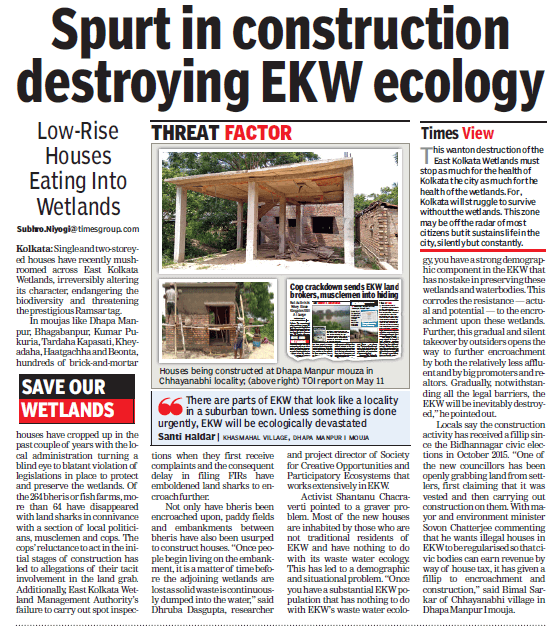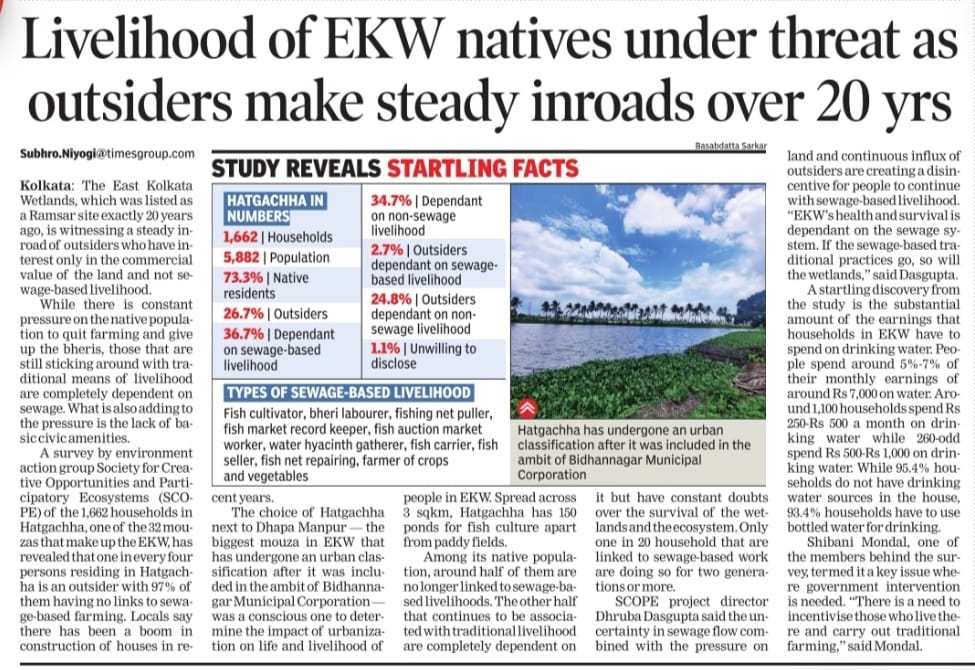

![]()



| Friday , June 30 , 2017 |
Eating into wetlands
– The East Calcutta Wetlands are being infringed upon by Sector V and the adjacent added areas of the corporation, reports Jayanta Basu

A strip of land going left from Ring Road in Sector V has been widened to allow four-wheelers to ply (below). This is evident in comparison to all the other dividers between bheris which are extremely narrow and allow only a single file of pedestrians. (Shubham Paul)
About two years back, Munshir Bheri, adjacent to Ring Road and further up from Nalban in Sector V, was just another water sprawl within the East Calcutta Wetlands through which the only way of communication was a barely walkable raised mud edge within the water bodies – aal in local parlance.
Now, that barely walkable mud edge has turned into a nearly 10 feet wide road linking Polenite, an added area, through which heavy motor vehicles have already started moving.
One may be tempted to call it an example of development but the development has come by violating norms that protect the East Calcutta Wetlands, the 125 sq km spread comprising mainly water bodies and low-lying agricultural land, which acts as the kidney of both Calcutta and Salt Lake.
While a high court order bars any land-use change within the East Calcutta Wetlands area, Ramsar listing of the wetlands — Ramsar is an international treaty which covers important wetlands and India is a signatory — mandates that no activity can take place which impacts the ecosystem of the wetlands area. Even the union government’s wetlands rules, 2010 ban any permanent construction within the wetlands.
Environmentalists point out that once the road becomes functional it will have regular traffic criss-crossing the wetlands area. That will take a toll on aquatic animals like Marsh Mongoose, a rare creature which is mostly found in the East Calcutta Wetlands as well as aquatic birds that frequent the water body spread around 44 hectares.

“The road has been erected without any clearance of the East Kolkata Wetland Management Authority (EKWMA), which is mandatory for any construction or land-use change planned within the East Calcutta Wetlands area,” said an EKWMA official. As the violation has been committed by a government organisation, the environment department has so far chosen to look away. But PUBLIC, an environment non-profit organisation, has gone to the court challenging the violation which is still pending before the eastern bench of the National Green Tribunal (NGT).
“Along with a few other violations, we have referred this one (road through water sprawl) to NGT where the representative of land and land reform department has already communicated that there was no proper road through the wetlands before,” said Bonani Kakkar of PUBLIC. The government claims that they have widened the existing road for the sake of local people.
However a government map, a copy of which is with The Telegraph Salt Lake, shows that there was earlier barely a demarcating boundary between Choto Munshi Bheri and Munshi Bheri.
“The state government representative claimed in the NGT hearing that they have widened an existing road for the sake of local people. But this violation indicates the trend. There is no doubt that Sector V is gradually eating into the East Calcutta Wetlands,” observed Kakkar.

Environment activists hang a banner prohibiting landfill in the wetlands area. Pictures by Mayukh Sengupta
Violations galore
The road through Munshir Bheri is just one instance of how the wetlands are being encroached upon. Filling up of water bodies and building realty is rampant in adjoining wards 35 and 36 of the Bidhannagar Municipal Corporation as well, a significant part of which falls within the East Calcutta Wetlands.
“There have been several violations in these wards — mainly filling up of water bodies and building constructions, especially within the designated wetlands area. And the trend is on the rise,” pointed out Dhruba Dasgupta, a wetland researcher.
“Recently we organised a mobile campaign through the wetlands and while passing through Ward 36, we could see that a partially built two- storeyed structure and other constructions had come up by filling up the wetlands area. Moreover, locals said that while a few water bodies had been already filled up, there are efforts to fill up the bigger water bodies,” said Naba Dutta of the green platform Sabuj Mancha.
Dutta also alleged that a large bheri, called Asok Ghosh’s Bheri, on the fringes of Bidhannagar Municipal Corporation area, off Sector V, has also been filled up. “Though there have been so many violations hardly any ground level action has been taken,” complained another wetland activist.

An illegal construction under way in Chhaynavi
Mayor’s lament
The complaints — and allegation of inaction — come even from the mayor himself. “I have received nearly a hundred complaints of water body fill-up, especially in the wetlands falling within the corporation area in the last few months and have forwarded those to all the departments concerned on my letter-head; but so far all that this has achieved is two acknowledgments,” mayor Sabyasachi Dutta told The Telegraph Salt Lake on Wednesday. Dutta also said that he had already lodged nearly 60 FIRs with various police stations.
According to sources, though more than 320 police complaints have also been lodged by the wetlands management authority, the government body supposed to look after the conservation of vital wetland area chaired by the environment minister, hardly any action has been taken at the ground level in most cases. Data available with the authority shows that out of 152 complaints lodged by them in the past three years, at least 10 to 15 per cent are either within the Bidhannagar Municipal Corporation or on its immediate fringes.
However despite the mayor’s open admission of violation within the wetland zone, the councillors of both wards 35 and 36 — Jaydev Naskar and Prabir Sardar respectively — told The Telegraph Salt Lake that they had “no knowledge of any water body filling” in their respective areas. Locals allege that people close to the councillors play pivotal role in these violations.
“Unless you have clearly demarcated administrative areas, proper land-use development control plan and, above all, political will nothing can be done,” observed urban environment expert Tapas Ghatak, a resident of Sourav Abasan, EE Block. Environment minister Sovan Chatterjee has recently sounded a war cry against those who have been filling up water bodies but locals living in the wetlands area feel that nothing would be achieved till the nexus between the local politicians and the local administrators is broken.

